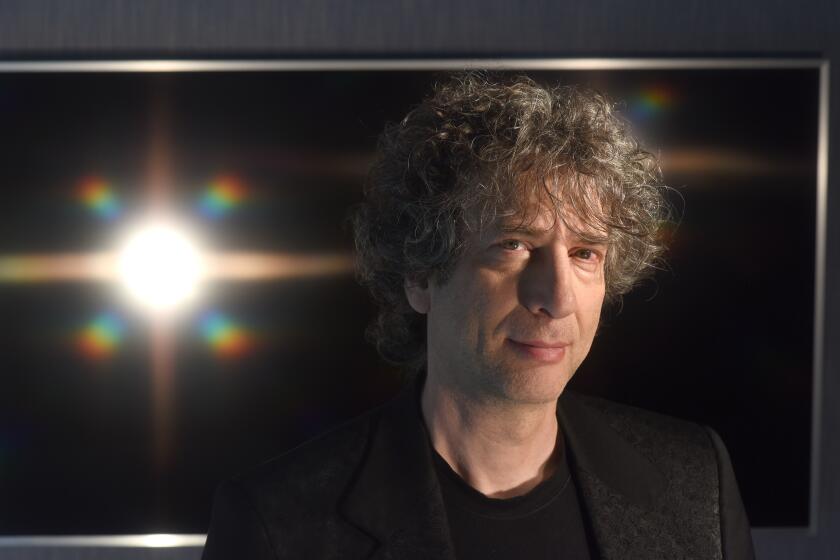A Study in Hip : SPEED TRIBES: Days and Nights With Japan’s Next Generation, <i> By Karl Taro Greenfeld (Harper Collins: $23; 287 pp.)</i>
- Share via
One could criticize “Speed Tribes” for any number of literary transgressions: Bad writing, shaky structure and strange characters that sometimes don’t fully represent the story.
Toss all that. “Speed Tribes” overcomes its flaws and is, in fact, an extraordinary trip into subterranean Tokyo. Tokyo author Karl Taro Greenfeld--who has dispatched these down-and-dirty stories for the likes of Los Angeles Times Magazine and Details--is the Douglas Coupland of Japanese youth culture; better, actually, since the L.A.-raised Greenfeld digs up nonfiction and Coupland dreams up his youth terrain.
Greenfeld brings readers a collection of stories on young Japan, from the motorcycle gangs they call “speed tribes” to the girls who dance and do drugs in Tokyo discos to the book worms who devote their lives to the all-important college-entrance exam. This is one of the first books to document Japanese youth culture. It is also one of the first to examine the effects of an unparalleled explosion of wealth on a Japanese generation of youth that didn’t have to work for it (sort of recalls America’s baby boom).
Sadly enough, “Speed Tribes” without an American peer: No work of this breadth has been published about modern American youth culture. Baby boomer Donna Gaines’ 1991 book “Teenage Wasteland: Suburbia’s Dead End Kids” comes close, but was much more narrow. Meanwhile, the Generation X publishing frenzy has produced some solid fiction (“The Secret History,” “Fast Sofa”) and a lot of sorry nonfiction (“Twentysomething American Dream,” “Prozac Nation”). If anything, perhaps “Speed Tribes”’ most important legacy is as a wake-up call about the need for an American counterpart. Greenfeld gets inside the youths that, for better or worse, have etched their own style into the rigid culture of Japan. Here we find out about fashion, drugs, groups of thugs, and even Japanese techno and metal music. The stories describe a rebellion against Japan’s solid work ethic, morals and conformism. As told by Greenfeld, Japan is the midst of a full-blown, Western-style pop explosion (Music critic Greil Marcus defines a pop explosion as “cultural upheaval that cuts across lines of class and race . . . and, most crucially, divides society itself by age”). Ironically, new pop explosions have been happening in the United States (electronic dance music culture, hip-hop jazz, spoken-word poetry, designer drugs and street fashion) that hardly get mentioned in American books. In fact, you might learn more about cutting-edge American youth culture by way of “Speed Tribes” than from any American novels.
Greenfeld talks of all-night dance clubs, designer drugs, kids who want to be DJs instead of rock stars--all things that originated in America. He does for Japanese youth culture what Tom Wolfe’s “The Pump House Gang” did for American youth culture in the hippy era. As Greenfeld’s deft reporting seems to show, it couldn’t have been easy.
Much of the book appears to have been written with the aid of reconstructive journalism. That is, it seems that Greenfeld had to conduct tiring interviews--probing the past thoughts, actions and settings of his characters in order to travel back to stories he probably didn’t witness. The storytelling is O.K.; the structure of a few stories is confusing; and Greenfeld’s attempts to translate Japanese culture can make for some strange similes (“Try raising a family in an apartment the size of a private detective’s office,” he writes). But the important thing is that the stories are told.
There’s the tale of the Nomu-kaypa (money drinkers)--low-level mafiosi who run gambling rings and bring violence to those who can’t pay up. There’s the bosozoku , racing-bike motorcycle gangs who party hard and perform small-time tasks for the Japanese mafia. One story gives the ins and outs of Japanese porn. Another is about night-club life. Greenfeld tops it off with a piece about how 350,000 hard-core otaku (hackers) swim in a sea of computer literacy. “The otaku ,” he writes, “may be the final stage in the symbiosis of man and machine.”
While American publishers chase after young writers who can come up with sob-story essays about their generation, Greenfeld brings us nonfiction from which to learn. He turns over the cold, hard stone of Japanese culture and finds life beneath. And he shows that maybe the center of the earth is shifting east: “In Tokyo,” he writes, “when traffic’s light and you’re in a good car with good suspension, the feeling of rolling fast on the elevated expressways over the wards and precincts of that immense city can be transcendent: you are in an artery, pumping through the heart of the world.”
More to Read
Sign up for our Book Club newsletter
Get the latest news, events and more from the Los Angeles Times Book Club, and help us get L.A. reading and talking.
You may occasionally receive promotional content from the Los Angeles Times.








